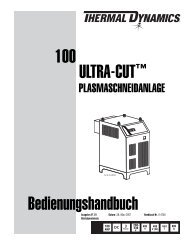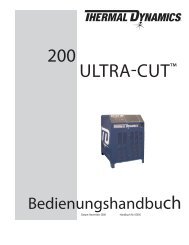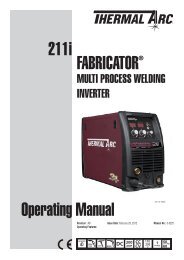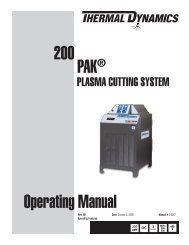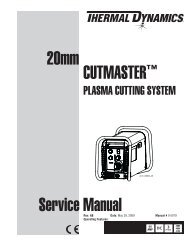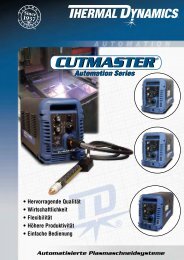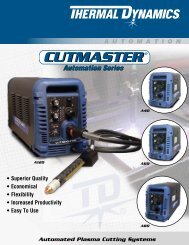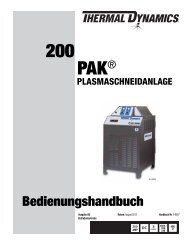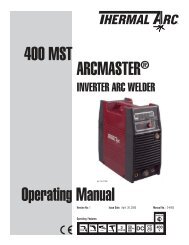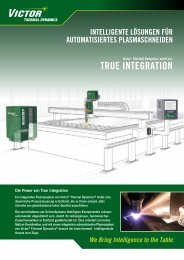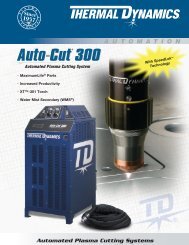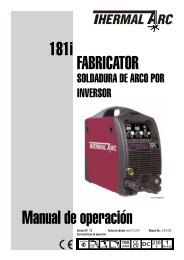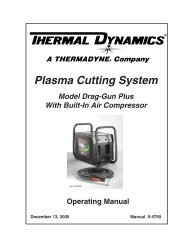CutMaster True Service Manual - Victor Technologies - Europe
CutMaster True Service Manual - Victor Technologies - Europe
CutMaster True Service Manual - Victor Technologies - Europe
Create successful ePaper yourself
Turn your PDF publications into a flip-book with our unique Google optimized e-Paper software.
CUTMASTER 35mm<br />
F. Torch Ratings<br />
Ambient<br />
Temperature<br />
<strong>Manual</strong> Torch Ratings<br />
104° F<br />
40° C<br />
Duty Cycle 100% @ 100 Amps @ 400 scfh<br />
Maximum Current 120 Amps<br />
Voltage (V peak ) 500V<br />
Arc Striking Voltage 7kV<br />
Ambient<br />
Temperature<br />
Mechanized Torch Ratings<br />
104° F<br />
40° C<br />
Duty Cycle 100% @ 100 Amps @ 400 scfh<br />
Maximum Current 120 Amps<br />
Voltage (V peak ) 500V<br />
Arc Striking Voltage 7kV<br />
G. Gas Requirements<br />
<strong>Manual</strong> and Mechanized Torch Gas<br />
Specifications<br />
Gas (Plasma and Secondary) Compressed Air<br />
Operating Pressure<br />
Refer to NOTE<br />
60 - 95 psi<br />
4.1 - 6.5 bar<br />
Maximum Input Pressure 125 psi / 8.6 bar<br />
Gas Flow (Cutting and Gouging)<br />
! WARNING<br />
300 - 500 scfh<br />
142 - 235 lpm<br />
This torch is not to be used with oxygen (O 2 ).<br />
NOTE<br />
Operating pressure varies with torch model, operating<br />
amperage, and torch leads length. Refer to<br />
gas pressure settings charts for each model.<br />
H. Direct Contact Hazard<br />
For standoff tip the recommended standoff is 3/16<br />
inches / 4.7 mm.<br />
2T.04 Options And Accessories<br />
For options and accessories, see section 6.<br />
2T.05 Introduction to Plasma<br />
A. Plasma Gas Flow<br />
Plasma is a gas which has been heated to an extremely<br />
high temperature and ionized so that it<br />
becomes electrically conductive. The plasma arc<br />
cutting and gouging processes use this plasma to<br />
transfer an electrical arc to the workpiece. The metal<br />
to be cut or removed is melted by the heat of the arc<br />
and then blown away.<br />
While the goal of plasma arc cutting is separation of<br />
the material, plasma arc gouging is used to remove<br />
metals to a controlled depth and width.<br />
In a Plasma Cutting Torch a cool gas enters Zone B,<br />
where a pilot arc between the electrode and the torch<br />
tip heats and ionizes the gas. The main cutting arc<br />
then transfers to the workpiece through the column<br />
of plasma gas in Zone C.<br />
INTRODUCTION 2T-2 <strong>Manual</strong> 0-5083<br />
_<br />
Power<br />
Supply<br />
+<br />
C<br />
Typical Torch Head Detail<br />
Workpiece<br />
A-00002<br />
By forcing the plasma gas and electric arc through a<br />
small orifice, the torch delivers a high concentration<br />
of heat to a small area. The stiff, constricted plasma<br />
arc is shown in Zone C. Direct current (DC) straight<br />
polarity is used for plasma cutting, as shown in the<br />
illustration.<br />
Zone A channels a secondary gas that cools the torch.<br />
This gas also assists the high velocity plasma gas in<br />
blowing the molten metal out of the cut allowing for<br />
a fast, slag - free cut.<br />
B<br />
A



